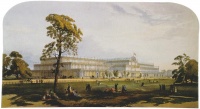1850s
From The Art and Popular Culture Encyclopedia
(Difference between revisions)
| Revision as of 18:37, 8 February 2008 Jahsonic (Talk | contribs) ← Previous diff |
Revision as of 23:25, 8 February 2008 Jahsonic (Talk | contribs) Next diff → |
||
| Line 1: | Line 1: | ||
| - | [[Image:The Crystal Palace.jpg|thumb|right|200px|This structure, built for the [[Great Exhibition]] of [[1851]], symbolizes the rise of [[consumer culture]] and the start of [[industrial design]].]] | + | [[Image:The Crystal Palace.jpg|thumb|right|200px|A huge [[iron]] and [[glass]] building, [[The Crystal Palace]] was one of the [[wonder]]s of, if not the [[world]], [[United Kingdom|Britain]]. A rebuilt and expanded version of the building that originally housed the [[Great Exhibition]] of [[1851]], it stood in [[Sydenham]] from [[1854]] until [[1936]], and attracted many thousands of visitors from all levels of society. The name "Crystal Palace" was coined by the satirical magazine [[Punch magazine|Punch]]. Today, it symbolizes [[modern architecture]], the rise of [[consumer culture]] and the start of [[industrial design]].]] |
| + | |||
| {{Template}} | {{Template}} | ||
Revision as of 23:25, 8 February 2008

A huge iron and glass building, The Crystal Palace was one of the wonders of, if not the world, Britain. A rebuilt and expanded version of the building that originally housed the Great Exhibition of 1851, it stood in Sydenham from 1854 until 1936, and attracted many thousands of visitors from all levels of society. The name "Crystal Palace" was coined by the satirical magazine Punch. Today, it symbolizes modern architecture, the rise of consumer culture and the start of industrial design.
|
Related e |
|
Featured: |
Art and culture
Births
Deaths
Unless indicated otherwise, the text in this article is either based on Wikipedia article "1850s" or another language Wikipedia page thereof used under the terms of the GNU Free Documentation License; or on research by Jahsonic and friends. See Art and Popular Culture's copyright notice.

